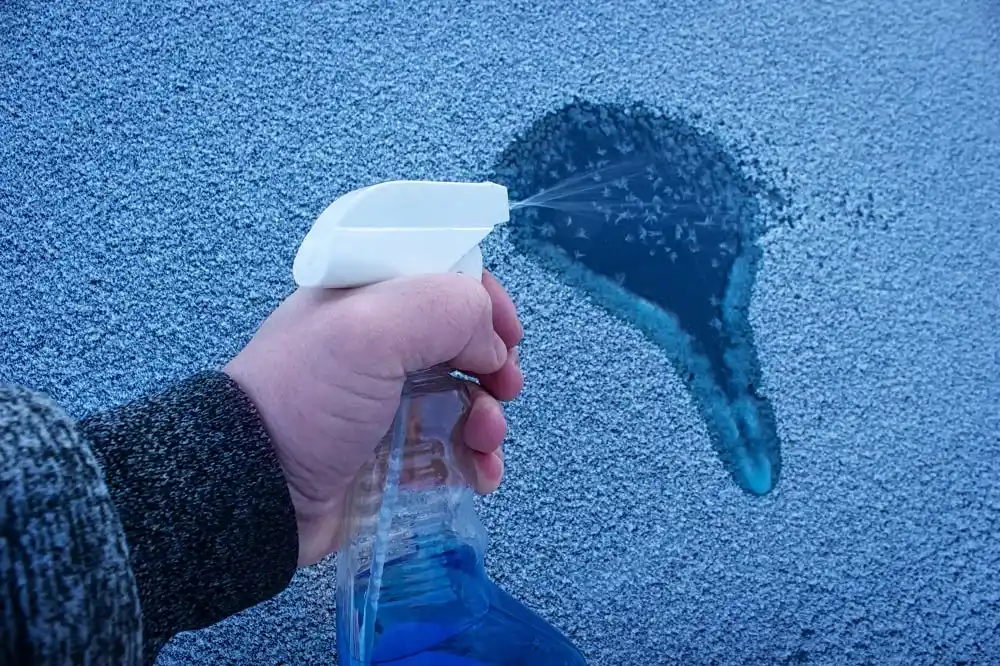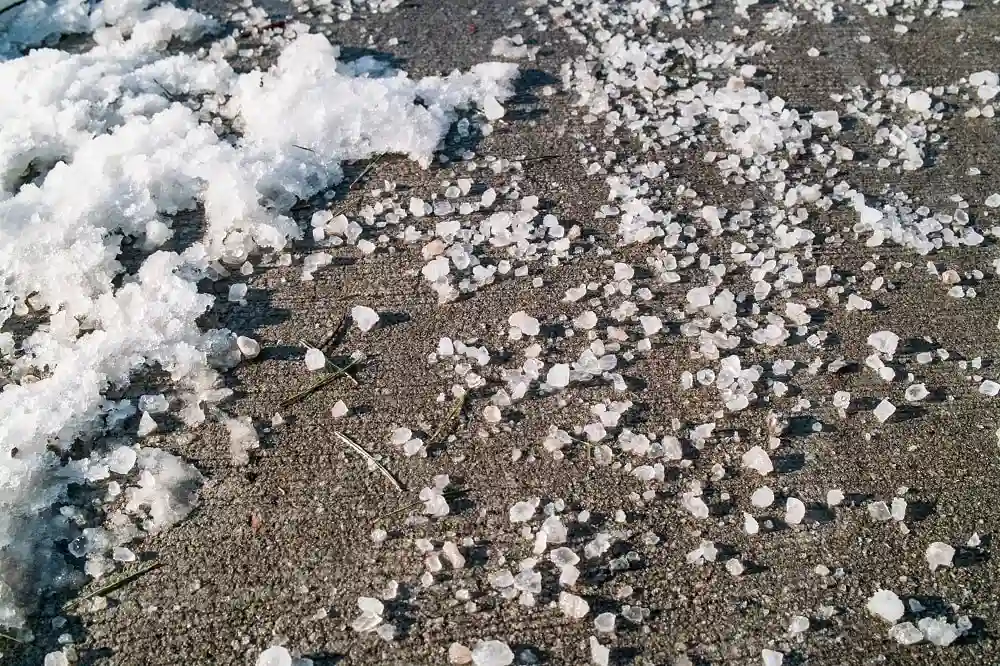As winter approaches, commercial snow and ice management is essential for keeping your property safe and accessible. When you’re choosing the best method for ice removal, you’ll find two popular options: liquid de-icer and rock salt.
Both have their pros and cons, but which is the most effective and efficient? We offer a comprehensive comparison of liquid de-icer and salt, exploring their effectiveness, application methods, costs, corrosive effects, and environmental impact. With our help, you’ll be equipped with the knowledge to decide on the best way to remove ice from your commercial property.
What Is a Liquid De-Icer?

Liquid de-icer, also known as liquid ice melt, is a solution used for snow and ice removal on roads, driveways, and other surfaces. It is typically made of a combination of salt brine and other liquids. When applied to surfaces, it effectively melts snow and ice, creating safer conditions for drivers and pedestrians.
This salt solution works by lowering the freezing point of water, preventing ice from forming or helping to break down existing ice. It is often preferred over traditional solid salt because it adheres better to surfaces, can be applied more evenly, and works faster in colder temperatures.
Liquid de-icer is widely used on airport tarmacs to ensure that planes have a dry and ice-free space to land even in adverse weather conditions — and if it’s good enough for airplanes, it can certainly work on surfaces used by cars and pedestrians!
What Is Rock Salt?

Rock salt, also known as traditional or bulk salt, is a common substance used for melting snow and ice. It is primarily made of sodium chloride derived from natural salt deposits.
When applied to icy surfaces, rock salt works like a liquid de-icer: It lowers the freezing point of water, causing the ice to melt. The salt particles mix with the moisture on the surface, forming a brine solution that breaks down and dissolves the ice. Rock salt is often spread manually or with a salt spreader for effective coverage on driveways, sidewalks, and roads.
Liquid De-Icer vs. Salt: A Comparative Analysis
Both liquid de-icer and salt are common options for keeping roads and sidewalks clear of ice and snow. However, there are some key differences between these ice-melting agents.
Effectiveness
The temperature plays a crucial role in the relative effectiveness of liquid de-icer and salt. Liquid ice melts are effective at lower temperatures than rock salt. They continue to work to melt ice and prevent refreezing even in sub-zero conditions.
While rock salt is widely used and effective at moderately low temperatures, it becomes less effective as the temperature drops below a certain threshold. In extremely cold conditions, liquid de-icer offers better results for rapid ice melting and safer surfaces.
More effective: Liquid de-icer
Application
Liquid de-icer and road salt differ in terms of application methods. Liquid ice melts are often applied using sprayers, allowing for more thorough surface coverage. This application method ensures better adherence, more even distribution, and quicker melting of ice and snow.
In contrast, rock salt is typically spread by hand or using salt spreaders, which may result in uneven coverage. While salt can be effective in smaller areas, the application method makes liquid de-icer ideal for larger spaces and more efficient snow and ice removal.
More convenient: Liquid de-icer
Cost
Several factors affect the costs of liquid de-icer and traditional rock salt. While rock salt often has a lower upfront cost, it may require larger quantities to effectively melt thick ice. Additionally, the manual labor and equipment needed for the proper application of rock salt can increase overall costs.
Liquid de-icer may have a higher upfront cost, but it requires smaller amounts for effective ice melting. Some users even create their own salt brine solution, further reducing costs. It’s important to assess the specific needs of the snow and ice removal project and determine which option provides the most cost-effective solution.
More affordable: Tie
Сorrosiveness
Liquid de-icers and salt differ in terms of their corrosiveness. Traditional salt, such as rock salt, can be corrosive to metal, concrete, and vegetation, leading to long-term damage.
In contrast, liquid de-icers, particularly those made with liquid brine and other ice melt products, are generally less corrosive. These solutions are formulated to minimize damage to surfaces and vegetation while effectively melting ice and snow. When it comes to preventing corrosion and minimizing potential damage to infrastructure, liquid de-icers are often a more favorable option.
Less damaging: Liquid de-icer
Environmental Impact
Liquid de-icer and salt differ in environmental impact when used for ice and snow removal. While both options have some impact, salt — especially in large quantities — can negatively affect plants, soil, and water bodies.
Liquid ice melts, on the other hand, are often formulated to be less harmful to the environment. They typically require smaller amounts for effective ice melting, minimizing the overall impact. Thus, liquid de-icers are generally considered to be a more environmentally friendly choice for maintaining safe and ice-free surfaces.
More eco-friendly: Liquid de-icer
5 Effective Tips for Applying De-Icers
For more effective snow and ice management, you should know how to apply de-icers correctly. Here are five additional tips to ensure proper application:
- Consider pretreatment: Pretreating surfaces with a liquid de-icer before a storm can help prevent ice from bonding and make ice and snow removal more manageable.
- Timing is crucial: If pretreatment isn’t possible, apply de-icers at the early stages of ice formation to prevent accumulation and facilitate easier removal.
- Follow the manufacturer’s instructions: Read and follow the guidelines provided by the de-icer manufacturer regarding application rates, timing, and surface compatibility.
- Use the right equipment: Invest in quality spreaders or sprayers designed for de-icer application to ensure even coverage and optimal effectiveness.
- Prioritize high-traffic areas: Focus on applying de-icer to walkways, entrances, parking lots, and other areas with heavy foot or vehicle traffic to minimize the risk of slips, skids, and falls.
By following these tips, you can effectively apply de-icers on your property to promote safe and smooth operations during winter months.
Liquid De-Icer vs. Rock Salt: What Is the Best Option for You?
When it comes to commercial snow removal, using an effective ice-melting agent is crucial for safety. While both liquid de-icer and salt have pros and cons, liquid products provide more efficient ice penetration and reduce environmental impact.
With decades of experience providing top-quality snow and ice management services, the team at Earth Development strategically applies liquid de-icers for optimal results. If you need help keeping your commercial property clear this winter, contact us today and learn more about our ice-melting expertise and our full range of snow and ice removal services.
